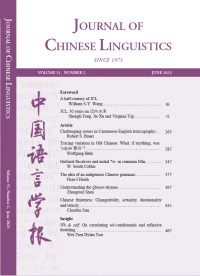Introduction and Scope
Journal of Chinese Linguistics (JCL) is a peer reviewed academic journal published biannually. Established in 1973, JCL explores Chinese languages and linguistics in the light of human complexity. The journal covers a wide range of areas of research including phonetics, phonology, morphology, syntax, semantics, pragmatics, applied linguistics, historical linguistics, computational linguistics, psycholinguistics, sociolinguistics, neurolinguistics, evolutionary linguistics and any other recognized facet of Chinese linguistics study. The JCL publishing office operated at the University of California at Berkeley, USA, from 1973 to 2007. It was relocated to The Chinese University of Hong Kong in 2008, and expanded its presence in China with the opening of a new office in Beijing Language and Culture University in 2019. On August 7, 2023, the Macao editorial office of the Journal was officially launched and the Chinese University of Hong Kong editorial office was restructured to a liaison office.
Journal of Chinese Linguistics also publishes monograph series. Please refer to the JCL Monograph Series (JCLMS) page for more details.
Editors: Shengli Feng, Beijing Language and Culture University
Jie Xu, University of Macau
Honorary Editor: William S-Y. Wang, The Hong Kong Polytechnic University

Official Statement of the Journal of Chinese Linguistics (JCL)
The Journal of Chinese Linguistics (JCL) hereby issues an official statement:
At no stage during the entire publication process of regular articles does the Journal charge authors any related fees in any form.
The official contact information of the Journal is as follows:
Official Website of the Journal of Chinese Linguistics (JCL):https://jcl.fah.um.edu.mo/
Macau Publishing Office: jcl_macao@um.edu.mo
Beijing Publishing Office: jcl2019@blcu.edu.cn
Hong Kong Liaison Office: jcl.liaison@gmail.com
We urge all authors to use the above official channels for manuscript submission and communication. If you encounter any suspicious situations, please contact the Journal via the official email addresses immediately to verify, so as to avoid financial losses.
Hereby declared!
Editorial Office of the Journal of Chinese Linguistics
News&Events
Recently Published Articles
Conversational uses of Mandarin Chinese buran (‘not so’) in casual conversations
Conversational uses of Mandarin Chinese buran (‘not so’) in
The topics were conditionals: The origin and evolution of a rGyalrong topic marker (in Chinese)
The topics were conditionals: The origin and evolution
Diffusion of the interrogative pronoun Sha ‘啥’ from Mandarin to Wu: A view of dialect contact (in Chinese)
Diffusion of the interrogative pronoun Sha ‘啥’ from Mandarin
On the modeling of homophony syllabary in Chinese dialects
On the modeling of homophony syllabary in Chinese
Ethic integration and evolution of the phonological features of Northern Standard Chinese Language
Ethic integration and evolution of the phonological features
Acoustic patterns in Hong Kong Cantonese hesitation markers: Vowel quality and omnisyllabic tone
Acoustic patterns in Hong Kong Cantonese hesitation markers:



